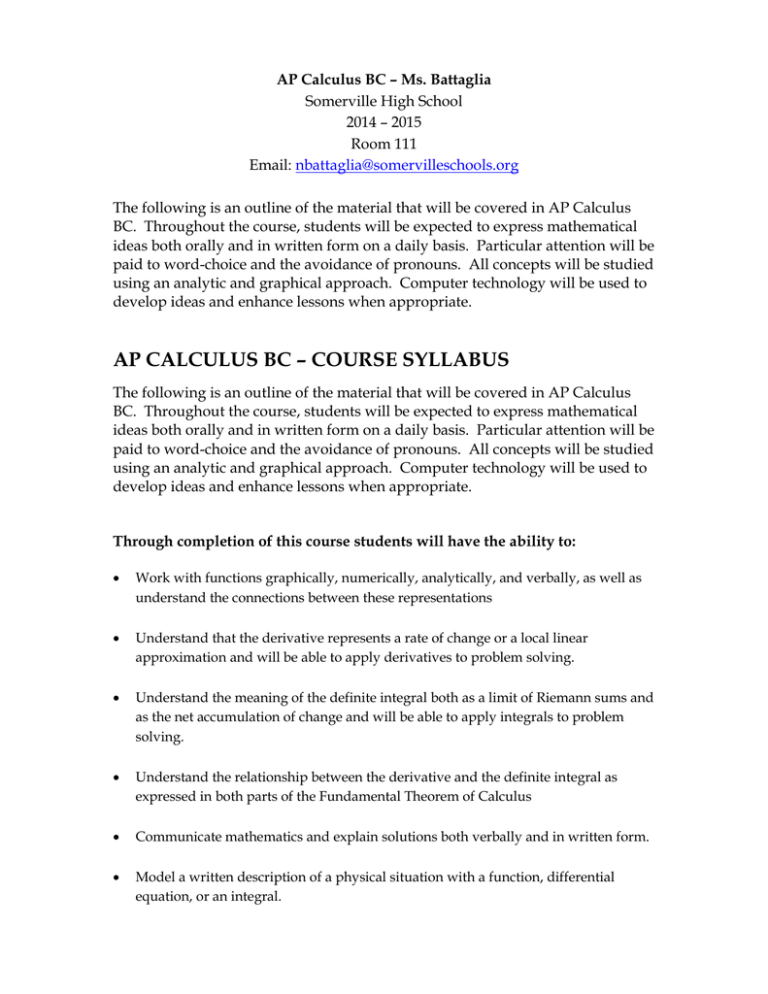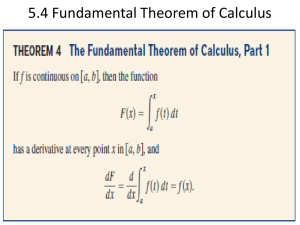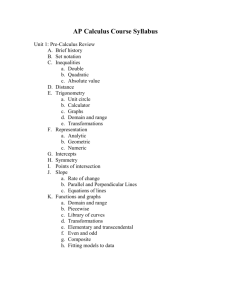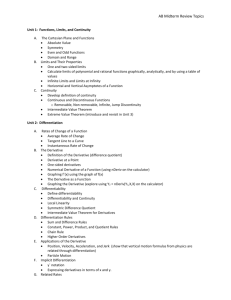
AP Calculus BC – Ms. Battaglia
Somerville High School
2014 – 2015
Room 111
Email: nbattaglia@somervilleschools.org
The following is an outline of the material that will be covered in AP Calculus
BC. Throughout the course, students will be expected to express mathematical
ideas both orally and in written form on a daily basis. Particular attention will be
paid to word-choice and the avoidance of pronouns. All concepts will be studied
using an analytic and graphical approach. Computer technology will be used to
develop ideas and enhance lessons when appropriate.
AP CALCULUS BC – COURSE SYLLABUS
The following is an outline of the material that will be covered in AP Calculus
BC. Throughout the course, students will be expected to express mathematical
ideas both orally and in written form on a daily basis. Particular attention will be
paid to word-choice and the avoidance of pronouns. All concepts will be studied
using an analytic and graphical approach. Computer technology will be used to
develop ideas and enhance lessons when appropriate.
Through completion of this course students will have the ability to:
Work with functions graphically, numerically, analytically, and verbally, as well as
understand the connections between these representations
Understand that the derivative represents a rate of change or a local linear
approximation and will be able to apply derivatives to problem solving.
Understand the meaning of the definite integral both as a limit of Riemann sums and
as the net accumulation of change and will be able to apply integrals to problem
solving.
Understand the relationship between the derivative and the definite integral as
expressed in both parts of the Fundamental Theorem of Calculus
Communicate mathematics and explain solutions both verbally and in written form.
Model a written description of a physical situation with a function, differential
equation, or an integral.
Use technology to help solve problems, experiment, interpret results, and justify
conclusions.
Verify the reasonableness of solutions, including sign, size, relative accuracy, and
units of measurement.
Appreciate calculus as a coherent body of knowledge and as a human
accomplishment.
Calculators
We will use a graphing calculator on a regular basis. I have a classroom set of TI84s but it is strongly suggested that you obtain your own calculator for work
outside of the classroom. A TI-84 or a TI-89 is recommended for this course. We
will be using the calculator to perform the following tasks:
Graph functions in arbitrary viewing windows
Calculate the zeros of a function (i.e. its x-intercepts)
Calculate the numerical derivative of a function
Calculate the numerical integral of a function
Interpret results and justify solutions obtained manually
Unit 1: Functions, Limits, and Continuity (7 days)
A. The Cartesian Plane and Functions
Absolute Value
Symmetry
Even and Odd Functions
Domain and Range
B. Limits and Their Properties
One and two-sided limits
sin x
1 and confirm graphically)
Squeeze Theorem (look at proof of lim
Calculate limits of polynomial and rational functions graphically,
analytically, and by using a table of values
Infinite Limits and Limits at Infinity
Horizontal and Vertical Asymptotes of a Function
x0 x
C. Continuity
Develop definition of continuity
Continuous and Discontinuous Functions
o Removable, Non-removable, Infinite, Jump Discontinuity (discuss y =
int(x) )
Intermediate Value Theorem
Extreme Value Theorem (introduce and revisit in Unit 3)
Unit 2: Differentiation (15 days)
A. Rates of Change of a Function
Average Rate of Change
Tangent Line to a Curve
Instantaneous Rate of Change
B. The Derivative
Definition of the Derivative (difference quotient)
Derivative at a Point
One-sided derivatives
Numerical Derivative of a Function (using nDeriv on the calculator)
Graphing f`(x) using the graph of f(x)
The Derivative as a Function
Graphing the Derivative (explore using Y2 = nDeriv(Y1,X,X) on the calculator)
C. Differentiability
Define differentiability
Differentiability and Continuity
Local Linearity
Symmetric Difference Quotient
Intermediate Value Theorem for Derivatives
D. Differentiation Rules
Sum and Difference Rules
Constant, Power, Product, and Quotient Rules
Chain Rule
Higher Order Derivatives
E. Applications of the Derivative
Position, Velocity, Acceleration, and Jerk (show that vertical motion
formulas from physics are related through differentiation)
Particle Motion
F. Implicit Differentiation
y` notation
Expressing derivatives in terms of x and y.
G. Related Rates
Unit 3: Applications of Differentiation (14 days)
A. Extema and Related Theorems
Absolute Extrema
Extreme Value Theorem
Relative Extrema
Critical Values
Rolle’s Theorem
Mean Value Theorem
B. Determining Function Behavior
Increasing and Decreasing Functions
First Derivative Test to Locate Relative Extrema
Concavity
Using the Second Derivative to Locate Points of Inflection
Second Derivative Test to Locate Relative Extrema
L’Hôpital’s Rule
The Relationship Between f(x), f`(x), and f``(x).
C. Optimization
D. Differentials
Local Linearity
Tangent Line Approximation
Newton’s Method*
Although this topic is not on the AP exam, it demonstrates a
practical application of the linear approximation model which I
believe will reinforce the concept with students.
Unit 4: Integration (12 days)
A. Antiderivatives
Indefinite Integrals
Initial Conditions and Particular Solutions
Basic Integration Rules
B. Area Under a Curve
RAM (Rectangle Approximation Method)
Riemann Sums
Left sums, right sums, midpoint sums
Definite Integrals
C. The Fundamental Theorem of Calculus
FTC Part 1
Numerical Integral (using fnInt on the calculator)
FTC Part 2
Mean Value Theorem for Integrals
Average Value of a Function
Integration by Substitution
Integrating with Respect to the x and y axes
D. Trapezoidal Rule
Unit 5: Transcendental Functions (12 days)
A. Trigonometric Functions
Differentiation
Integration
B. Inverse Trigonometric Functions
Differentiation
Integration
General Rule for Derivative of an Inverse Function
C. Exponential and Logarithmic Functions
Unit 6: Advanced Integration (14 days)
A. Substitution with Complete Change of Variable
B. Integration by Parts
C. Partial Fractions (non-repeating linear factors only)
D. Improper Integrals
Unit 7: Differential Equations (8 days)
A. Slope Fields
B. Euler’s Method
C. Separable Differentiable Equations
D. Exponential Growth and Decay (including their use in modeling)
E. Logistic Differential Equations (including carrying capacity and their use in
modeling)
Unit 8: Applications of Integration (14 days)
A. Net Change
Distance vs. Displacement of a Particle in Motion
Consumption over time
B. Area of a Region Between Two Curves
Integrating with Respect to the x and y axes
C. Volume of 3-dimensional Regions
Disk Method
Shell Method
Known Cross Sections
Unit 9: Sequence and Series (16 days)
A. Sequences
Types: Arithmetic, Geometric, Harmonic, Alternating Harmonic
Convergence and Divergence
Monotonic and Bounded Sequences
L’Hopital’s Rule to Determine Convergence
B. Series
Sequence of Partial Sums
Convergence and Divergence
Tests for Convergence or Divergence: nth-term, geometric series, telescoping
series, p-series, alternating series, integral, root, ratio, direct comparison,
limit comparison
C. Taylor Polynomials
Approximation of Transcendental Curves Using Polynomials
Express Functions as Maclaurin and Taylor Polynomials
Differentiation and Integration of Taylor Polynomials
Radius and Intervals of Convergence of a Power Series
Lagrange Error Estimation
Unit 10: Polar and Parametric Equations and Vectors (12 days)
A. Parametric Equations
Conversion between rectangular and parametric forms
Differentiation and Integration
Length of a Parametric Curve
B. Polar Equations
Conversion between rectangular and polar form
Differentiation and Integration
Area Bound by Polar Curves
Length of a Polar Curve
C. Vectors
Properties of Vectors
Dot and Cross Products
Differentiation and Integration of Vector-Values Functions
Velocity and Acceleration of Objects Modeled by Twice-differentiable
Functions of Time
Unit 11: Review and AP Exam Preparation (15 days)
A. Multiple Choice Practice
B. Free Response Practice
Rubric Review
Self-scoring using rubric
Peer evaluation of written responses
After the AP Exam
Projects related to the applications of the derivative and solids of
revolution
Conic Sections and their Calculus
Hyperbolic Functions
Textbook
Larson and Edwards. Calculus of a Single Variable (AP Edition). Ninth Edition.
Brooks/Cole, 2010.
Supplemental Reference Materials
Finney, Demana, Waits, and Kennedy. Calculus – Graphical, Numerical, Algebraic. Second
Edition. Pearson, Prentice Hall, 2006.
AP Calculus Workshop Handbook, College Board, 2008-2009.
Apcentral.collegeboard.com
Software
Texas Instruments TI-83 Flash Debugger
Texas Instruments TI-SmartView for TI-84
Geometer Sketchpad
Calculus in Motion.
GRADING
Tests
Quizzes
60% of your final grade
40% of your final grade
**Other Projects will be graded as I deem necessary
The lowest quiz grade will be dropped marking periods 1-3.
If you have a question or concern about your grade, you must make an
appointment with me after class, during lunch, or before or after school.
DO NOT ASK ME ABOUT YOUR GRADE DURING CLASS TIME.
ABSENCES
Students will have ONE day for each day you are absent to make up the
work.
If you miss a test or quiz, you must make it up the FIRST DAY you return
to school.
PLAGIARISM / ACADEMIC DISHONESTY POLICY:
Plagiarism and academic dishonesty are serious offenses. The academic
work of a student is expected to be his/her own effort. Students must give
the author(s) credit for any source material used. Students who commit
any act of academic dishonesty will receive a failing grade in that portion
of the course work. Acts of academic dishonesty will be reported to the
administration.
EXPECTATIONS AND RULES
I have very high expectations for this class. If you perform to the best of
your ability, you will succeed. I look forward to helping you in any way
during the school year and will be available if you need extra help. The
following are specific rules of the classroom:
o FOLLOW THE RULES OF THE SCHOOL
o Be on time! You must be in your seat and ready to work when the
bell rings.
o Be prepared! Bring daily-required materials to class every day.
o Be respectful! Show respect to everyone and everything!
o The teacher dismisses the class, not the bell!
DISCIPLINE POLICY FOR RULE VIOLATION
1st Offense: Verbal warning
2nd Offense: Teacher/student conference
3rd Offense: Phone call home
4th Offense: Detention before school, after school, or during lunch
5th Offense: Referral
I look forward to working with you this year!







